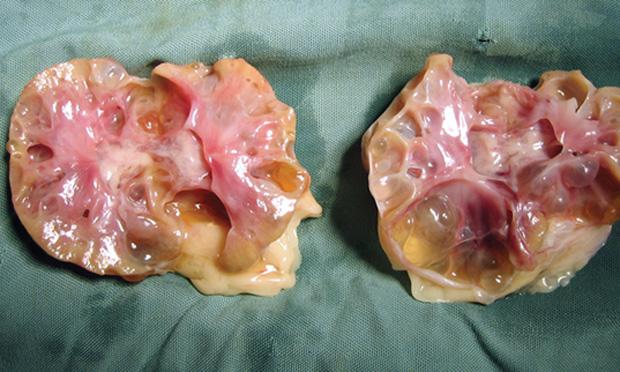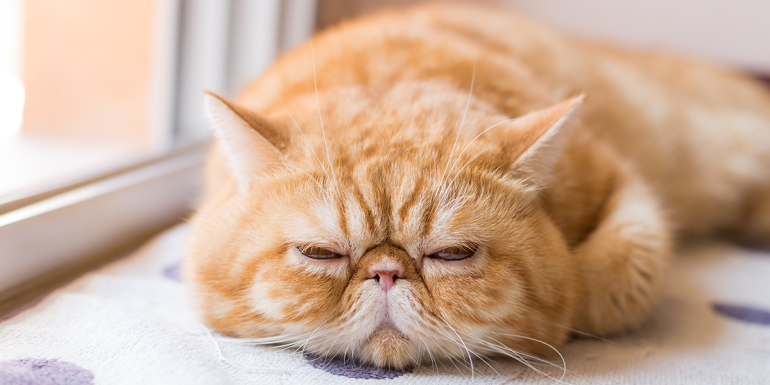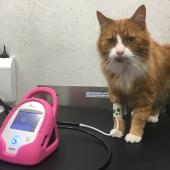Autosomal dominant polycystic kidney disease

Autosomal dominant polycystic kidney disease
Autosomal dominant polycystic kidney disease (AD-PKD) is an inherited condition (passed from parents to their kittens) that can cause progressive kidney failure in cats. The disease has become particularly common in Persian and Exotic Shorthaired cats.
In the future it may be possible to eliminate this potentially fatal disease by careful breeding from unaffected individuals. To assist in this, International Cat Care (formerly the Feline Advisory Bureau (FAB)) has set up a register of AD-PKD negative cats from these breeds in the UK.

What is AD-PKD?
Autosomal dominant polycystic kidney disease (known as AD-PKD) is an inherited condition that can cause severe kidney failure in cats. The disease causes small, fluid filled holes (cysts) to form in the kidney, and these gradually get larger as the cat gets older. As the cysts get bigger the kidneys are unable to work normally and kidney failure will eventually occur, but the time course of this is very variable.
A defective gene is the source of the illness. All cats carrying the faulty gene will eventually get AD-PKD, however since the disease doesn't normally show symptoms until adulthood, a cat may procreate a lot and give the disease to its kittens before developing symptoms. Therefore, before using breeding cats of high-risk breeds for reproduction, it is imperative to check for the existence of the gene.
Can AD-PKD be treated?
Kidney disease in cats with AD-PKD progresses over time and eventually results in renal failure. There is no cure for the illness, but if your cat does experience renal failure, there are treatments that can help prolong its life. Sadly, the illness always has a deadly end. Making ensuring that affected cats are not let to procreate is the only way to stop other cats from experiencing the same tragedy in the future.
How is AD-PKD passed on?
AD-PKD is a hereditary illness that is genetically transmitted from parents to children. Because the impacted gene is autosomal dominant, both sexes are impacted. All cats who inherit even a single copy of the defective gene will develop AD-PKD; the disease can be transferred from one parent to another infecting some of the kittens. Queens with mild disease can give birth to kids with severe disease, and vice versa.
Which cats are at risk of AD-PKD?
AD-PKD is a very rare condition in breeds other than those that are, or are related to Persians and Exotic shorthairs. Persian cats throughout the world appear to have an especially high chance of having AD-PKD.
Past figures identified that 1/3 of Persians cats in the UK are affected, and numbers are similar throughout the world. Other breeds, related to Persians, are also at high risk of the disease. The disease is common in Exotic shorthairs, with 3 in 10 testing positive for AD-PKD. Other breeds which may have imported the AD-PKD gene through previous outcrosses with Persian cats include British shorthairs, Himalayans, exotic shorthair breeds, Burmillas and possibly Maine Coons.

Breeds with a high risk of AD-PKD include:
- Persians
- Exotic shorthairs
- British shorthairs
Breeds at moderate risk include:
- Asian
- Burmilla
- Bombay
- Tiffanie
- Birman
- Cornish Rex
- Devon Rex
- Ragdoll
- Snowshoe
Breeds at low risk include:
- Abyssinian
- Angora
- Balinese
- Bengal
- Burmese
- Egyptian Mau
- Korat
- Maine Coon
- Norwegian Forest Cat
- Ocicat
- Oriental Longhair
- Oriental Shorthair
- Russian Blue
- Siamese
- Singapura
- Somali
- Tonkinese
- Turkish Van
How do I know if my cat has PKD?
A large number of cats with AD-PKD could not show any obvious signs. Cats with kidney ailment typically show symptoms between the ages of three and ten; most cats start showing symptoms at seven years old. Symptoms include increased thirst, increased frequency or volume of urination, decreased appetite, constipation, vomiting, weight loss, and occasionally blood in the urine.
Cats who have renal failure can be assessed for the condition even before symptoms manifest. Breeding cats from high-risk breeds should have an AD-PKD screening before being used for breeding. If your cat is from a breed that is prone to AD-PKD, it might have arrived with a certification from the breeder. If neither parent has the illness, AD-PKD won't afflict your cat.
If the parents of your cat have not had testing and your cat is in a high-risk breed, you can schedule a gene test. The test uses DNA from either a blood sample or a swab taken from the inside of the cat's mouth. Kittens that are breastfeeding must have a blood sample taken. Another way to check for the illness in cats older than 10 months is to use ultrasound scanning.
Symptoms
ADPKD in cats may not manifest noticeable symptoms until the disease has progressed significantly. Common signs include:
-
Increased Thirst and Urination: Cats may drink more water and urinate more frequently due to compromised kidney function.
-
Decreased Appetite and Weight Loss: Cats with ADPKD may experience a loss of appetite, leading to weight loss.
-
Abdominal Pain: Some cats might exhibit discomfort or pain in the abdominal area.
-
Vomiting and Diarrhea: Digestive issues can arise as the disease progresses.
-
High Blood Pressure: ADPKD can lead to hypertension (high blood pressure) in affected cats.
What does the gene test involve?
Collections of cells from the cat's mouth or from a blood sample are required for the AD-PKD gene test. Next, the sample is forwarded to a recognized laboratory that provides the gene test. Veterinary Genetics Laboratory, University College, Davis, California is the facility where the test was invented; many breeders also use it. There are two accredited laboratories in the UK: Langford Veterinary Diagnostics and the Animal Health Trust.
Cats must also have an identity microchip in order to be eligible for entry on the International Cat Care AD-PKD negative registry. The number of the microchip must be noted by a veterinarian on the submission form that is sent with the sample to the lab.
Is there any other way to test for the disease?
Kidney cysts can be identified via ultrasound scanning. Routine scanning makes it easy to identify significant cysts, much way human pregnancy tests do. This is helpful for cats with advanced AD-PKD, such as those who already have kidney failure or have enlarged kidneys. To enable the ultrasound to make excellent contact with the skin, a little area of fur will need to be cut. The liver can also include cysts.
Pre-breeding screening calls for a more specialized method because the cysts are probably small and difficult to spot. A specialized ultrasonographer employing a high definition device must do the scan. Because the cysts may be too small to detect before this time, cats must be 10 months old to receive a certificate stating that they do not have PKD.
The cat must be scanned by an authorized ultrasonographer and have an identifying microchip that can be read at the time of scanning so that its identity can be verified in order for it to be eligible for entry on the AD-PKD negative register.
Where can I get my cat ultrasound scanned for AD-PKD?
An experienced ultrasonographer is required to perform the AD-PKD ultrasound test on breeding cats in order to ensure accuracy of the results. A gene test might be more suited if you would like your negative cats to be listed on the AD-PKD negative register.
Your own physician might be able to scan your cat and determine whether or not it has significant kidney cysts if you do not want to reproduce from it.
Will other tests be needed if my cat has AD-PKD?
The effectiveness of your cat's kidneys may need to be evaluated by additional testing. Testing for blood and urine may be among them. In order to assess the course of the disease, cats with AD-PKD should ideally have urine and ultrasonography tests performed every six to twelve months.
How do I find a kitten without AD-PKD?
All of the breeding cats from reputable Persian and exotic shorthaired cat breeders are tested for AD-PKD. If neither parent has an illness, then neither will the children. It is sometimes necessary for a breeder to have a litter of kittens from an affected cat; in these situations, it is anticipated that some of the kittens will not be impacted. Thus, it is possible to determine which of the kittens have the condition and which do not by doing gene tests on them.
The International Cat Care runs an AD-PKD negative register listing cats that have been verifiably tested to AD-PKD and have been found to be negative. For more information visit the International Cat Care website at www.icatcare.org.
Management and Treatment
While there is no cure for ADPKD, supportive care and management can improve a cat's quality of life:
-
Dietary Management: Specialized kidney diets with controlled protein and phosphorus levels can ease the workload on the kidneys and manage symptoms.
-
Fluid Therapy: Intravenous fluids may be administered to maintain hydration and support kidney function.
-
Blood Pressure Management: Medications to control high blood pressure can help slow down the progression of kidney damage.
-
Regular Veterinary Check-ups: Cats with ADPKD require frequent veterinary monitoring to assess kidney function, blood pressure, and overall health.
-
Pain Management: Pain medications may be prescribed to alleviate discomfort and improve the cat's well-being.
-
Avoiding Breeding Affected Cats: Responsible breeding practices involve avoiding mating cats known to carry the ADPKD gene, preventing the spread of the disorder to future generations.
Conclusion
ADPKD in cats is a serious genetic disorder that requires lifelong management and care. Cat owners should work closely with veterinarians to provide the necessary support, including appropriate diet, medication, and regular check-ups. Early detection, proper management, and responsible breeding practices can help improve the lives of affected cats and prevent the spread of this genetic condition to future feline generations.





